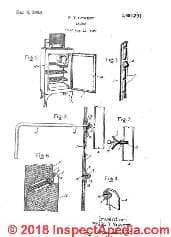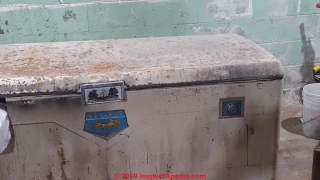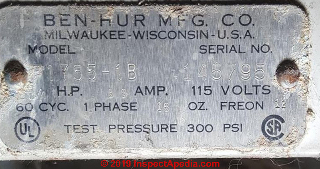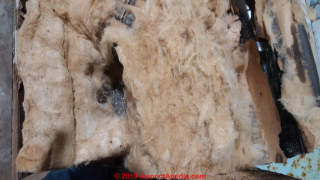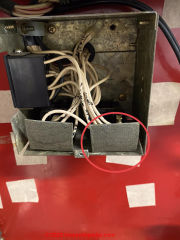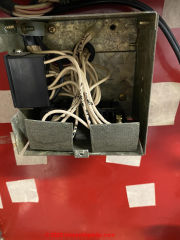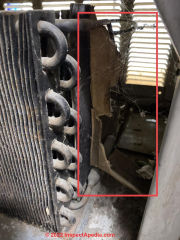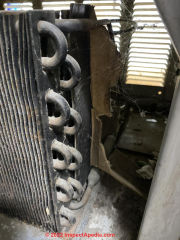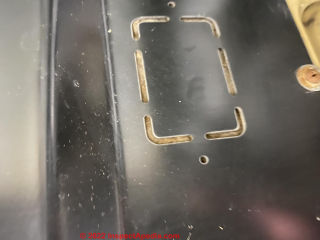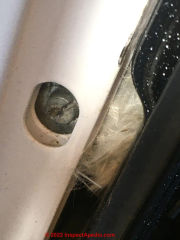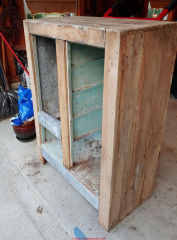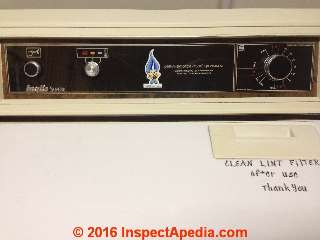 Asbestos Use in Appliances
Asbestos Use in Appliances
Asbestos contained in household appliances or appliance components
- POST a QUESTION or COMMENT about what building products and common in building products, appliances, mechanical components were produced using asbestos materials
Asbestos was used in some building & household appliances as gasket material, insulating material, or fire-proofing material.
Asbestos might be found in some household appliances such as clothes dryers, hair dryers, irons, toasters, and even refrigerators, though usually that asbestos is well covered and harmless.
This article series provides a master list of the forms in which asbestos was used, a list of known asbestos-containing materials, and links to detailed articles about individual asbestos-containing products & materials found in buildings and in a wide range of products used in both home and industry.
InspectAPedia tolerates no conflicts of interest. We have no relationship with advertisers, products, or services discussed at this website.
Use of Asbestos in Home Appliances
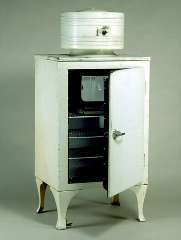 Here we list household appliances that might contain asbestos and we describe the forms in which asbestos might appear in appliances.
Here we list household appliances that might contain asbestos and we describe the forms in which asbestos might appear in appliances.
Asbestos was widely used in many gas & electrical appliances as a heat shield, as a gasket, as insulation, and sometimes as a structural component.
Watch out: Don't panic about possible asbestos in a toaster, iron, or refrigerator. In most instances even when asbestos was used in a friable form it was enclosed within appliance walls or components.
The asbestos hazard from its presence in home appliances is likely to be below the limits of detection unless you disassemble and chop, grind, or saw these materials.
Asbestos may also appear in building or home appliances as a secondary product such as asbestos used in electrical wire insulation in toasters or irons, or in a high-temperature-resistant light bulb.
For products that have been left intact, not dis-assembled nor damaged, most appliances (hair dryers may be an exception) were not found to release enough asbestos that it was detected in air around the product when the product was in use.
Illustration: a 1927 GE Monitor Top refrigerator (Museums Victoria) that probably does not contain asbestos. [Click to enlarge any image]
Asbestos was used in these home appliances and possibly others that we will describe on this page: broilers, coffee pots, clothes dryers, coffee pots, in cookstoves (Moffatt and others), coolers, cooktops, deep fryers, dishwashers (possibly), ranges, refrigerators, irons & iron rests, toasters, electric heaters, ovens, popcorn poppers, vacuum cleaners, and washing machines.
Other household items used in the kitchen such as pot holders and some ironing board covers used asbestos fabrics.
Asbestos in Coffee Pots
Asbestos was used in electrical wire insulation and insulation in some electric coffee pots.
Asbestos Used in Electric Blankets
Several sources report use of asbestos in electric blankets, as we cite in the article given below.
See details at ASBESTOS in BLANKETS
Asbestos in portable electric heaters
Asbestos was widely used to carry electric heating elements, in heat-resistant wiring, and possibly in other components in electric heaters manufactured (in the U.S.) up to 1974.
Asbestos in dryers, clothes dryers
Research DOES confirm that asbestos was used in some older clothes dryers from the 1940's and 1950's and possibly extending in North America at least into the late 1970's .
See ASBESTOS in CLOTHES DRYERS where we discuss asbestos use in clothes dryers and washing machines, including gaskets and clothes dryer belts and in clothes dryer electrical components.
Asbestos in hair dryers
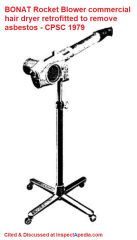 Hair dryers containing asbestos were sold in the U.S. by many companies including AEC, American Electric, Bonair, Clairol, Conair, General Electric, Gillette, Hamilton Beach, J.C. Penny, Korvettes, Montgomery Ward, Norelco, North American Philips, Shick, Sears Roebuck & Co., Sperry Rand (Remington), Sunbeam and others up to 1979 or 1980 when US CPSC recalls were issued.
Hair dryers containing asbestos were sold in the U.S. by many companies including AEC, American Electric, Bonair, Clairol, Conair, General Electric, Gillette, Hamilton Beach, J.C. Penny, Korvettes, Montgomery Ward, Norelco, North American Philips, Shick, Sears Roebuck & Co., Sperry Rand (Remington), Sunbeam and others up to 1979 or 1980 when US CPSC recalls were issued.
In the U.S., following a U.S. CPSC study finding dangerous amounts of asbestos release from hair dryers from eleven hair dryer manufacturers, those companies issued a voluntary refund and return policy and they stopped manufacturing asbestos-containing hair dryers.
There have been, however, few documented cases of actual mesothelioma traced to exposure to asbestos-containing hair dryers. (Dahlgren 2015).
Asbestos is not likely to be found in a hair dryer manufactured after 1980.
Furthermore, in the U.S. companies who produced hair dryers that contained asbestos agreed to a recall in May, 1979. The CPSC documents we provide below list the manufacturers and the hair dryer models concerned.
It is a violation of federal law to sell a product that has been recalled by the US CPSC.
Some hair dryers such as the commercial Rocket Blower (Bonat) shown here were retrofitted to address asbestos hazards in those appliances.
Research on the History of Asbestos in Hair Dryers
- Cohn, Murray S., Paul D. White, and Peter W. Preuss. "Consumer product safety: Risk assessment of exposure to asbestos emissions from hand-held hair dryers: Response to rebuttal of William Hallenbeck." Environmental Management 5, no. 2 (1981): 91-93.
- Dahlgren, James, and Patrick Talbott. CASE REPORT: PERITONEAL MESOTHELIOMA FROM ASBESTOS IN HAIRDRYERS [PDF] International journal of occupational and environmental health 21, no. 1 (2015): 1-4., retrieved 2021/06/22 original source: NCBI, U.S. National Library of Medicine, NIH, National Institute of Health, https://www.ncbi.nlm.nih.gov/pmc/articles/PMC4273513/
Abstract:
The relationship between mesothelioma and exposure to asbestos is well established. As a result, the use of asbestos in buildings, construction sites, and mines, as well as the implications of disease for the workers has received considerable attention.
However, asbestos was also used in household equipment and consumer products, including hairdryers. To examine one case of peritoneal mesothelioma in a hairdresser and review the relevant literature on asbestos exposure from hairdryers.
The subject's medical and occupational records were obtained and reviewed and a physical examination was performed. The results indicate that the subject developed peritoneal mesothelioma from her occupational exposure to asbestos containing hairdryers in accordance with the literature.
Hairdryers are possible sources of asbestos exposure in patients with mesothelioma, and the asbestos exposure risk is higher for those who use hairdryers occupationally. - Geraci, C. L., P. A. Baron, J. W. Carter, and D. L. Smith. Testing of hair dryers for asbestos emissions. No. PB-89-165237/XAB. National Inst. for Occupational Safety and Health, Cincinnati, OH (USA). Div. of Physical Sciences and Engineering, 1979.
- Hallenbeck, William H. "Consumer product safety: Risk assessment of exposure to asbestos emissions from hand-held hair dryers." Environmental Management 5, no. 1 (1981): 23-32.
Abstract:
The United States Consumer Product Safety Commission (CPSC) is concerned that consumer exposure to asbestos from consumer products may present an unreasonable risk of injury. Recently, CPSC has obtained agreement by industry to cease production and distribution of hair dryers containing asbestos heat insulation.
CPSC intends to broaden its investigation by selecting consumer products containing asbestos for “priority attention.” The Commission does not intend to make quantitative estimates of cancer risks posed by exposure to asbestos fibers in making regulatory decisions.
This position may lead to a serious waste of resources for the Commission, industry, and society. The Commission should focus its initial attention on those products for which the release of asbestos is significant enough to cause an unreasonable health risk. To make a risk assessment for a particular use of asbestos, CPSC must acquire or request data on asbestos emissions and define “unreasonable risk to health.”
In an attempt to give some meaning to the phrase “risk assessment,” the primary goal of this paper is to present a detailed risk assessment of exposure to asbestos from hand-held hair dryers.
Several scenarios of use are presented using various assumptions regarding time of operation, mixing of fibers in a small room, rate of fiber emission, and time of exposure. The worst case analysis of the health risk of exposure to hair dryer emissions is based on several conservative assumptions and shows that the increased number of deaths per year due to respiratory cancer is 4 for the entire United States population. A more representative case analysis shows the increased number of deaths to be on the order of 0.15 per year. - U.S. Consumer Product Safety Commission. 1979. Consumer products containing asbestos; advance notice of proposed rulemaking.Federal Register 44(202): 60057–60061.
- U.S. CPSC, NEW INFORMATION on HAIR DRYERS; CPSC HOT-LINE SWAMPED by CALLS, 22 August 1979 [PDF]
- U.S. CPSC, CPSC ACCEPTS CORRECTIVE ACTIONS FROM MAJOR HAIR DRYER COMPANIES, 21 May 1979, [PDF] excerpted below:
WASHINGTON, D.C., May 21, 1979 -- The Consumer Products Safety Commission voted unanimously yesterday to approve voluntary corrective action proposals by the 11 major manufacturers and private labelers of hand-held hair dryers manufactured with asbestos.
The corrective actions by these companies, which account for an estimated 90 per cent of all domestic hair dryer sales annually, provide for either repair, replacement or refund for hand-held hair dryers containing asbestos. The companies which have agreed to accept returns of hair dryers containing asbestos from consumers are: Conair Corp.; General Electric Co.; Gillette Co.; Korvettes, Inc.; Montgomery Ward; North American Philips Corp. (Norelco); J.C. Penney Co.; Scovill Manufacturing Co. (Hamilton-Beach and Dominion); Sears, Roebuck & Co.; Sunbeam and Schick, Inc.
Attached are news bulletins providing details of the corrective actions being taken by 10 of the 11 major companies. Although the Commission has accepted the corrective action proposal of Schick, Inc., a news bulletin announcing Schick's program is not available at this time. - U.S. CPSC, ADDITIONAL HAIR DRYERS MADE WITH ASBESTOS to BE REPAIRED by THEIR TWO MANUFACTURERS, 22 April 1980 Op. Cit. 22 April 1980
- U.S. CPSC HEAT GUNS CONTAINING ASBESTOS RECALLED, 17 April 1979
- U.S. CPSC COMMISSION APPOVES CORRECTIOVE PLANS for 26 MANUFACTUERS of ASBESTOS HAIR DRYER, 1 November 1979 [PDF]
- U.S. CPSC, COMMISSION ACCEPTS ASBESTOS CORRECTION PLAN FROM COMMERCIAL HAIR DRYER MANUFACTURER, 20 September 1979
The U.S. CPSC and [Bonat] the manufacturer of the "Rocket Blower", a commercial hair dryer used nationwide in beauty salons patronized primarily by blacks, today announced a voluntary program for the removal and replacement of asbestos heat shields in the hair dryers. The correction program has been accepted by the Commission as adequate.
Asbestos in clothing irons & hair curling irons
Asbestos was used as early as 1900 in irons that were heated on stovetops where asbestos formed part of heat-resistant handles on those irons.
Asbestos was also used in electric irons manufactured into the 1950's: asbestos appeared in an iron sold by Sears Roebuck between 1957 and 1958 - source: U.S. Congressional Record, V. 149, Pt. 11, June 20, 2003 to June 19, 2003
Asbestos was used in iron rests such as Craftmade™ iron rests (Norton Accessories Manufacturers, NY) until 1960.
Asbestos was also used in home and commercial pressing pads and in larger ironing machines and manglers.
Asbestos was used in hair curling irons. ( Droogenb1965).
We found patents citing use of asbestos in steam irons and clothing irons as late as 1980. ( McMullen 1980).
- Droogenb, Jean Francois Dit Rog, and Antoon Joseph Johan Iren Camil. "Implement for setting hair." U.S. Patent 3,220,421, issued November 30, 1965.
Excerpts:
In the example illustrated, the element 4 is constituted by a spring having joining convolutions and inside which is housed a cylindrical asbestos wick ...The sheath 2 is provided with one or more rows of ports or perforations 16 located at suitable points so as to allow the outlet of the vapors produced by the liquid contained in the sheath and imbibing the asbestos. - Joseph, D. Alessandro. "Flat-iron provided with a steam ejection device." U.S. Patent 3,184,871, issued May 25, 1965.
- Melvin, Gershon. "Press pad." U.S. Patent 2,482,412, issued September 20, 1949.
- McMullen, Alan R. "Steam iron with low temperature soleplate." U.S. Patent 4,233,763, issued November 18, 1980.
- Oivind, Meidell Birger. "Steam developing device for flatirons." U.S. Patent 1,963,858, issued June 19, 1934.
Asbestos in ironing boards, various manufacturers, using asbestos based cloth, possibly also asbestos based heat insulating padding.
Asbestos used in Refrigerators
Above: patent discussing use of asbestos in refrigerator gaskets. [Click to enlarge any image]
Reader Question: Did the old 1927 GE Monitor top refrigerator have asbestos? - Alyssa 2018/03/11
Reply: Asbestos was not found mentioned in patent research for the 1927 GE Monitor Top refrigerator - illustrated above on this page.
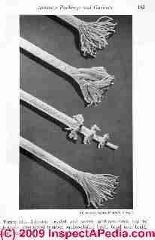 Possibly, but my research did not find any mention of asbestos in the description of the GE monitor-top refrigerators. The GE Monitor Top refrigerator was a major product development for General Electric and was widely sold and is still recognized world-wide.
Possibly, but my research did not find any mention of asbestos in the description of the GE monitor-top refrigerators. The GE Monitor Top refrigerator was a major product development for General Electric and was widely sold and is still recognized world-wide.
I searched particularly for refrigerator insulation and for refrigerator gaskets and gasket patents associated with GE from 1925 - 1930 to see if those mentioned use of asbestos and did not find that indicator.
- Givens, Albert L. "Refrigerator." U.S. Patent 1,533,646, issued April 14, 1925. Original Assignee General Electric Co
- Griffiths, Richard T. "Packing gasket and method of making same." U.S. Patent 1,705,455, issued March 12, 1929.
- Sywert, Philip T. "Gasket." U.S. Patent 1,694,291, issued December 4, 1928. (I include an image from this patent)
Asbestos could also have been used as a refrigerator body or door insulating material, though I did not find that either (yet - I'm still researching).
Other patents from the same era such as Carrey (1930) do cite use of asbestos in the refrigerator construction.
- Carrey, John O. "Vacuous refrigerator and method of maintaining vacuum therein." U.S. Patent 1,747,969, issued February 18, 1930. Original Assignee C & C Engineering Company Inc.
Excerpt:
A U-shaped strip 24 of heat non-conducting material such as asbestos is placed over the bent edge 20 and a thin sheet 25 of lead is then placed over the U-shaped strip 24 and the whole is then forced into the pocket 23, and the assembled joint has the lead covering 25 bearing against the inner face of rebent edge 21 and the edge from edge 21 by asbestos covering 24.
Also Ballew (1925) describes use of asbestos in the refrigerator doors:
- Ballew, Neual W. "Vacuum-insulated container." U.S. Patent 1,561,769, issued November 17, 1925.
Excerpt:
The inner shells each contact with the outer shell only over a small surface at its front end. The doors 4:, where they contact with the outer shell may be lined with a suitable heat insulating material, such as cork or asbestos, not shown.
Asbestos in Freezers & Ice Chests
We have an old Ben Hur chest freezer from the 50s. Do these appliances contain asbestos?
On 2020-02-10 by (mod) -
Sara,
Thank you for the.Ben Hur freezer asbestos question.
I don't know that specific brand and if you can give me photos of the logo of the chest and of any data tags, it would help me research its history for a more definitive answer to the asbestos question. You can post one photo per comment.
. The place to look for asbestos on a freezer would be at the door gaskets. It's possible that asbestos was used as insulating material, but most likely that would be sealed inside the metal walls of the freezer chest. My location it couldn't be a hazard unless you managed to rip the chest apart.
On 2020-02-10 by Chuck Beams
I'm not sure you got the pic or my comments so I am doing it again. Freezer is Ben Hur Model 1755 -B Serial # 145795.
On 2020-02-11 by (mod) -
On 2020-02-11 by Chuck Beams
I don't see Patent numbers at all just this plate with model and serial info.
Also have a picture of the material in question as I did a small cut away to view it.
Let me know if you want to see it. Thanks again
On 2020-02-11 by (mod) -
Yes of course
On 2020-02-11 by Chuck Beams
Material in question. Looks like Fiberglass but not sure because of the age of this unit
On 2020-02-11 by (mod) -
Chuck that is almost certainly fiberglass.
We have not found any authoritative sources confirming the mixture of asbestos directly with fiberglass insulating batts or insulating blankets though asbestos paper was found on some mineral wool or rock-wool insluation batts or "blankets".
The most-common building (and perhaps appliance) insulating material that might contain asbestos is Vermiculite.
See VERMICULITE INSULATION - home - for details.
The other common uses of asbestos in appliances included
- Asbestos-rope gaskets - ASBESTOS PACKINGS & GASKETS
- Asbestos-electrical wire insulation - on appliances where heat was a concern, such as electric irons and some stove top igniters
ASBESTOS ELECTRICAL WIRE INSULATION
On 2020-02-11 by Chuck Beams
Do you know of a way I can get documentation on this Freezer or contact email, phone # . Does some else now own what use to be Ben Hur Manufacturing.
There has to be some trail left behind I would think just for the fact of the possibility that asbestos could have been used in appliances dating back to this time. From my understanding some fiberglass insulation was manufactured with asbestos as an ingredient.
Also is there a way to positively test the material to assure that we are safe and I can confidently dispose of the unit once I cut it up and get it out of the basement and who would be best suited to handle this for disposal. Sorry for all the question answer stuff but I want to be absolutely safe not only for the occupants in the home but for environmental aspect. Thanks again for your help.
On 2020-02-12 by (mod) -
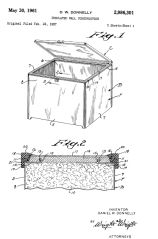 Asbestos is not an ingredient if fiberglass insulation; they are separate materials;
Asbestos is not an ingredient if fiberglass insulation; they are separate materials;
There can, of course, be cross-contamination among materials depending on where they were manufactured, stored, used, etc.
You can certainly send a sample of your suspect material to a certified asbestos test lab.
In the ARTICLE INDEX given above you'll find an ASBESTOS TEST LAB LIST
More on the history of Ben Hur Freezers is found in some of the company's patent disclosures
Anderson, Leland J., and Stoner Charles Ward. "Combination freezer and dehumidifier." U.S. Patent 2,865,181, issued December 23, 1958. Application filed by Ben Hur Mfg Company
Donnelly, Daniel W. "Insulated wall construction." U.S. Patent 2,986,301, issued May 30, 1961. Application filed by Ben Hur Mfg Company
See inspectapedia.com/Appliances/Ben-Hur-Freezer-Patent-US2986301.pdf - this patent discusses freezer chest insulation - the word "asbestos" does not appear.
On 2020-02-12 y Chuck Beams
Thank you so much for your hard work to find this information for me. Although it does not specifically state which insulating material they used to pack the walls with, I would hope the material is not asbestos.
Another question would be is, would asbestos not be one of the options they employed in construction, and I quote "any desired type of heating insulation material" as stated in this patent at the time when these units were being constructed.
Asbestos in Toasters & Toaster Covers
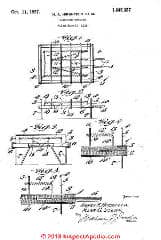 Asbestos was widely used in toasters in several forms including electrical wire insulation, toaster side insulation, and heating element carriers from about 1910 through the 1970's and in some toaster appliances even into the mid 1980's.
Asbestos was widely used in toasters in several forms including electrical wire insulation, toaster side insulation, and heating element carriers from about 1910 through the 1970's and in some toaster appliances even into the mid 1980's.
Asbestos was also used in toaster covers (Landry 1981).
Butler (1903) patented a hand-held bread toaster (not-electric) that used or might use asbestos as one of the early U.S. patents citing use of asbestos in toasters.
Asbestos was still being used in toaster appliances in 1982 (Zim 1982) and is described in baking and frying appliances in 1984 (Matz 1984).
- Anderson, Roy J. "Electric toaster." U.S. Patent 2,548,511, issued April 10, 1951.
- Barton, Ruth. "Household technology in Western Australia 1900-1950." Oral History Association of Australia Journal, The 7 (1985): 108.
Excerpt:
In East Fremantle, about 1910, they heated their iron on a flat piece of asbestos laid over the top of a primus stove rather than on ...
See details at ASBESTOS PRODUCTS in AUSTRALIA - Butler, Louis F. "Bread-toaster." U.S. Patent 743,688, issued November 10, 1903.
Excerpt:
This invention relates to the class of breadtoasters in which a wire-netting or analogous open-work metallic sheet is superposed upon a heat-transmitting plate of asbestos or other suitable fireproof material. - Christoph, E.A., "Electric Toaster", U.S. Patent 1,393,427 , issued 10/11/1921
Cites use of asbestos in the supporting board for heating elements in the toaster. - Clark, Newman S. "Toaster." U.S. Patent 888,960, issued May 26, 1908.
Excerpt:
In the preparation of my device, I make a mixture composed of about 50 parts of fire-clay, 25 parts of clean sharp sand, 10 parts of asbestos, and 15 parts of wheat bran. This mixture properly moistened and adherent may be formed in molds into disks or plates of any suitable description. - Hirshfeld, Harry A., and Allan G. Stern. "Electric toaster." U.S. Patent 1,645,327, issued October 11, 1927. [Illustrated here]
Excerpt:
... waste asbestos board may be employed, and these parts shall be hereinafter referred to as asbestos boards or sheets, although not limited to i this material.
The supporting parts for the above described base are formed of wire. each support comprising asingle piece. of wire bent to form a horizontal, laterally extended top part 4
having vertical portions 5, bent at 6 to engage around the strip 3 and thereafter bent downwardly and upwardly to form legs 7
It will be understood that these supports may be detached, for packing purposes, so as to reduce the bulk of the device. Arranged in the same horizontal plane with the top parts 4 of said supports are other horizontally arranged, laterally extended wires 8 having vertical partis 9 and parts 10 bent around the strips 3.V
The end wires and intermediate wires are used to receive, for instance, bread and the like vto be toasted, the edible being supportedqby said wires free of the heating element. The heating element, which 1s designated 12, is supported by hook-like parts 13 of staples 14.
The staples 13 pierce the uppermost asbestos sheet or plate, are extended horizontally thereunder, as at 14', are passed up through said upper sheet of asbestos, and are clamped over the top surface of said upper asbestos sheet. - Hall, T., "Bread or Other Toaster", U.S. Patent 689,182, issued December 17, 1901 - cites use of asbestos in the parts of this non-electric toaster.
- Landry, Jean-Guy. "Cover for use on a toaster." U.S. Patent 4,254,695, issued March 10, 1981.
Excerpt:
The cover is preferably made of two layers of metal 26 and 28 and a layer of heat-insulating material 30, such as asbestos, is sandwiched between the two layers 26 and 28 at the top of its embossed portion. - Lemaster, Charles A. "Toaster." U.S. Patent 1,661,294, issued March 6, 1928. - Cites use of asbestos in the supporting board for heating elements in the toaster.
- Matz, Samuel A. "Equipment for Frying, Baking, and Drying." In Snack Food Technology, pp. 231-250. Springer, Dordrecht, 1984.
Excerpt:
Sheet material composed essentially of asbestos fibers and binders can be used as both insulation and a structural component. In this case, an outer covering is not necessary … FIG. 18.2. Toaster oven. - Snyder, Paul V. "Electric toaster heating unit." U.S. Patent 3,283,128, issued November 1, 1966.
Excerpt:
In perhaps its simplest form, the heating unit of the invention includes a relatively stiff resistance heating wire formed into a sinous series of loops which are secured at -their ends to an elongated support strip of insulation material such as asbestos. - Zirn, Rudolf F., and Erich Karlsen. "Insulating container for cooking food." U.S. Patent 4,323,167, issued April 6, 1982.
Excerpt: This disc 9 may be made of asbestos, rubber, glass fiber reinforced plastic or like heat-resistant and inexpensive material.
Other Possible Sources of Asbestos Used Within Appliance Components
- Asbestos in large vs small Appliances - research
Hwang, Sung Ho, and Wha Me Park. "EVALUATION OF ASBESTOS-CONTAINING PRODUCTS AND RELEASED FIBERS IN HOME APPLIANCES." [PDF] Journal of the Air & Waste Management Association 66, no. 9 (2016): 922-929.
Abstract: The purpose of this study was to detect asbestos-containing products and released asbestos fibers from home appliances. The authors investigated a total of 414 appliances manufactured between 1986 and 2007. Appliances were divided into three categories: large-sized electric appliances, small-sized electric appliances, and household items.
Analysis for asbestos-containing material (ACM) was performed using polarized light microscopy (PLM) and stereoscopic microscopy.
Air sampling was performed to measure airborne concentration of asbestos using a phase-contrast microscope (PCM). The results of the analysis for ACM in appliances show that large-sized electric appliances (refrigerators, washing machines, kimchi-refrigerators) and household items (bicycles, motorcycles, gas boilers) contain asbestos material and small-sized electric appliances do not contain asbestos material.
All appliances with detected asbestos material showed typical characteristics of chrysotile (7–50%) and tremolite (7–10%). No released fibers of ACM were detected from the tested appliances when the appliances were operating.
This study gives the basic information on asbestos risk to people who use home appliances.
Implications: All appliances with detected asbestos material showed typical characteristics of chrysotile (7–50%) and tremolite (7–10%).
No released fibers of ACM were detected from the tested appliances when the appliances were operating. - Asbestos in Electric Motors: Asbestos Compound for encasing motor windings -
see ASBESTOS ELECTRICAL WIRE INSULATION - Asbestos electrical wiring insulation -
see ASBESTOS ELECTRICAL WIRE INSULATION - Asbestos Fabrics & Textiles & Cloth -
see ASBESTOS TEXTILES - Asbestos Felt was used in products such as acoustical liners, noise insulation, adhesives, plastics.
The properties of asbestos felts are described in table 9.2 found
at ASBESTOS in PLASTICS - Asbestos in Filters are discussed in detail
at ASBESTOS FILTERS - Asbestos in appliance insulation - possibly,
see ASBESTOS INSULATION - Asbestos in light bulbs, Light bulbs, lamps, room deodorizers & fragrance dispensers are discussed
at LIGHT BULB ASBESTOS USE
Our complete list of products and materials that made use of asbestos is found
Note that asbestos may be present in still other substances and even products, not by its deliberate use or design, but because it occurs naturally, such as asbestos that is found in some talc powders (amphibole asbestos).
CONTACT US to add items and photographs to this list of asbestos containing materials used in or on appliances.
Asbestos in Appliances Research
- Hwang, Sung Ho, and Wha Me Park. EVALUATION of ASBESTOS-CONTAINING PRODUCTS & RELEASED FIBERS in HOME APPLIANCES [PDF] Journal of the Air & Waste Management Association, Volume 66, 2016 - Issue 9: A Special Issue of JA&WMA on NOAA's 7th International Workshop on Air Quality Forecasting Research (IWAQFR)
Abstract:
The purpose of this study was to detect asbestos-containing products and released asbestos fibers from home appliances. The authors investigated a total of 414 appliances manufactured between 1986 and 2007.
Appliances were divided into three categories: large-sized electric appliances, small-sized electric appliances, and household items. Analysis for asbestos-containing material (ACM) was performed using polarized light microscopy (PLM) and stereoscopic microscopy. Air sampling was performed to measure airborne concentration of asbestos using a phase-contrast microscope (PCM).
The results of the analysis for ACM in appliances show that large-sized electric appliances (refrigerators, washing machines, kimchi-refrigerators) and household items (bicycles, motorcycles, gas boilers) contain asbestos material and small-sized electric appliances do not contain asbestos material.
All appliances with detected asbestos material showed typical characteristics of chrysotile (7–50%) and tremolite (7–10%).
No released fibers of ACM were detected from the tested appliances when the appliances were operating.
This study gives the basic information on asbestos risk to people who use home appliances.
Implications: All appliances with detected asbestos material showed typical characteristics of chrysotile (7–50%) and tremolite (7–10%). No released fibers of ACM were detected from the tested appliances when the appliances were operating.|
Excerpt:
… In this study, asbestos was not detected in the air around the asbestos-containing products when the products were in use, because ACM was firmly seated in the inner parts of the … - New Jersey, ASBESTOS, A GUIDE for NEW JERSEY RESIDENTS [PDF], NJ Department of Health & Senior Services, Consumer, Environmental & Occupational Health Service Indoor Environments Program PO Box 369 Trenton, NJ 08625-0369 Phone: 609-826-4950 Fax: 609-826-4975 state.nj.us/health/iep - retrieved 2023/05/06, original source: rucore.libraries.rutgers.edu
"As long as an appliance that contains asbestos is not broken or improperly used, it should be safe. With normal use, it is unlikely that the asbestos in these products will create a hazard. Don’t attempt to repair any of these appliances yourself, take them to the manufacturer or dispose of them."
Reader Comments, Questions & Answers About The Article Above
Below you will find questions and answers previously posted on this page at its page bottom reader comment box.
Reader Q&A - also see RECOMMENDED ARTICLES & FAQs
On 2022-12-08 by InspectApedia (Editor) (mod) - asbestos in Australian boat refrigerator?
@Mark caulfield,
A 1953 refrigerasoldier Australia might contain asbestos and insulation and conceivably in a door gasket. Take a look at
https://inspectapedia.com/hazmat/Asbestos-in-Appliances.php
ASBESTOS USES IN APPLIANCES
And on that page if you want to post some photos of your refrigerator, particularly a photo of the whole refrigerator then of a door gasket and then of his data tag we can do some further research.
You can only post one photo per comment but you can use as many comments as you need.
On 2022-12-07 0 by Mark caulfield
I have a boat built in 1953 in Australia that has a refrigerator in it. I need to cut holes in the walls of the fridge and wonder if there could be asbestos insulation behind the walls. Is it possible that asbestos was used to insulate marine fridges from this period?
On 2022-11-03 by InspectApedia (Editor) - asbestos in General Electric alarm clock radio from the 80s
@Anonymous,
Possibly as an internal heat shield if the radio uses tubes otherwise it seems unlikely
On 2022-11-03 by Anonymous
Would asbestos have been used in a General Electric alarm clock radio from the 80s? Thanks!
On 2022-04-06 by Inspectapedia Com Moderator - Does this 1960s vintage vending machine parts and components contain asbestos?
@Michael diaz,
Thanks for raising an asbestos question not already in our catalog.
But yes there were some electrical flash guard paper products that used asbestos - probably combined with other materials to provide some rigidity. I've read that that flash guard paper also found it way into some consumer products, toys, ashtrays, and appliances.
Here is some quick research on flash guard products that used asbestos
Smith, Marvin W. "Flash guard for dynamo-electric machines." U.S. Patent 1,448,419, issued March 13, 1923.
I. F. PHEILS, FLASH LIGHT ATTACHMENT FOR PHOTOGRAPHIC CAMERAs, US Patent No. 576,821. Patented Feb. 9, 1897
Schmid, Edson S. "Insulator assembly." U.S. Patent 2,502,756, issued April 4, 1950.
and similarly
Meyer, Svend Martin. "Electric cigar-lighting apparatus." U.S. Patent 844,610, issued February 19, 1907.
On 2022-04-06 by Michael diaz
Thanks so much for your insight. Those are intact masking tape on the body. Can you look at the red circle of this image? I think they call it flash paper to protect the electrical connections. Thanks.
@Inspectapedia Com Moderator,
On 2022-04-06 by Inspectapedia Com Moderator
@Michael Diaz,
I can't quite make out that white material, but it looks like a thin adhesive tape.
On 2022-04-06 by Michael Diaz
This is an image of the paper around the electrical component
On 2022-04-07 by Inspectapedia Com Moderator
@Michael diaz,
Just a guess: that fibrous-paper material may have been intended as an air barrier to reduce the chances of condensate splashing off of the coil onto electrical components on the other side of the barrier. If you see start/run capacitors, relays, etc. behind that barrier those may have been protected.
For equipment made in the U.S. before 1986, asbestos is certainly possible, but consider the size, location, volume of material; it's not enough to warrant high concern. If your equipment continues in use and you've the slightest worry, remove and dispose of the questionable paper barrier and put up a modern and suitable replacement to protect the wiring - if that's indeed what it's doing.
On 2022-04-06 by Anonymous
Thanks again for your insight. Here is an image of the condenser and the compressor. On the side there appears to be a paper type barrier (red square). It appears damaged but judging from the spider webs it must have been damaged a long time ago. What do you think this might be ? What is the best way to remove this? Any chance this barrier contains asbestos?
@Inspectapedia Com Moderator,
On 2022-04-06 by Inspectapedia Com Moderator
@Michael diaz,
Fiberglass insulation is quite easy to recognize and is distinctive enough that testing to identify that material would not normally be needed.
Take a look at FIBERGLASS INSULATION IDENTIFICATION & PROPERTIES
On 2022-04-06 by Michael diaz
Hello: I have acquired a vintage vending machine. I believe there may be fiberglass insulation in the door as well as the tub. This is not exposed at all; I only discovered in after removing a screw and seeing what looked like yellowish fiberglass insulation. There is also what appears to be a paper type of insulation surrounding some of the electrical components that are sealed In a protective metal box (cover removed for photos).
The machine is a Vendo 190D, most likely built mid to late 1960’s. I have included a picture of the back of the door which is a black plastic casing. Through the casing I can see some of the insulation. There is also the paper around the electrical competent. On the side of the compressor is some paper as well.
Do you think any of this contains asbestos.? I don’t plan to expose any of it but I would like to clean the bottom,of the machine where the compressor is located and remove that paper. Please let me know what you think. Thanks.
On 2022-01-11 by Inspectapedia Com Moderator
@Stephanie Robinson,
Possible but unlikely; one cannot say whether or not your oven insulation contains asbestos based just on a text message.
A photo would be helpful.
Most likely you're looking at fiberglass.
On 2022-01-09 by Stephanie Robinson
We have a very old Brother combination oven (i.e.microwave/convection oven). My husband took the back off it yesterday and it revealed some fibrous insulating material. Could this be asbestos? We think the combination oven may be around 30 years old, maybe even older.
On 2021-11-11 5 by Inspectapedia Com Moderator - Was asbestos used in light bulbs?
@Lynda M,
Thank you for a helpful question on asbestos in light bulbs in the UK
Please find your question and our detailed reply now at
ASBESTOS in LIGHT BULBS
and don't hesitate to post follow-up questions, comments, suggestions, photos
On 2021-11-10 by Lynda M
I am trying to find out if asbestos was used in the manufacture of lightbulbs in the 1940s. Any info much appreciated!
On 2021-08-18 by Mark
@inspectapedia.com.moderator,
Many thanks once again for your quick reply and for sharing your knowledge of such things.
Mark
On 2021-08-18 by inspectapedia.com.moderator - Fiberglass insulation in Swiss oven
@Mark,
I remember the Russian - Italian house - that was pretty special.
About your photo: I see what looks like fiberglass insulation.
On 2021-08-18 by Mark
Hi there!
Second time using your expertise! First was regarding possible asbestos in insulation panels in a pre-fab Russian house imported to northern Italy.
This time we have an oven in an apartment in Switzerland that has started moulting!
On one side you can see this material that I presume is insulation. Is it asbestos or dangerous?
Many thanks in advance.
Mark
On 2021-06-22 by inspectapedia.com.moderator - determining if asbestos was in a hair dryer
@Dyanne Kelly,
Thank you again for your question; driven by it, we've reviewed government and other records and resources and have added that detail to the article above at
ASBESTOS in HAIR DRYERS
I'm not sure how you arrived at 1983 or 1984 as the safe date considering that the year in which, in general, US manufacturers stop using asbestos in all products was 1986.
About a Black & Decker hair dryer, you'd probably want to research just which actual hair dryer manufacturer with whom B&D contracted to have their branded hair dryers produced. Even if the company used offshore or Chinese manufacturers you'd not expect B&D to knowingly violate U.S. federal statutes.
From a literature review there seems to be small chance that a hair dryer actually manufactured after 1979 would contain asbestos, given
1. the significant publicity around the concern for asbestos in hair dryers, independent of what other research asserts was an infinitesimally small risk
2. the 1979 and 1980 recalls of hair dryers in the U.S.
3. the clear statement that selling a product that has been recalled by the CPSC is a violation of federal law
While we can't unequivocally tell by eye if an appliance has asbestos or not, it might be reasonable to look closely at the hair dryer to see if all of the components, through which it moves air are either plastic or metal. If there is no fibrous material that would be asbestos-suspect, that might close the question.
Please let us know if you have additional questions, a photo, or the above noted reference for a certain year.
On 2021-06-21 by Dyanne Kelly
Hello, I have exhaustively searched to see if a Black and Decker bonnet hair dryer HD21D contained asbestos. I can't find anything on it. I'm unable to find the year it was manufactured. I did find articles stating Black and Decker acquired GE small appliances in 1983. This hair dryer looks exactly like the GE model.
This leads me to assume Black and Decker didn't start manufacturing this dryer until possibly 1984 so it should be okay but I'm still feeling nervous. Do you have any information on this? I'd love to be able to use this hair dryer.
On 2020-03-11 by danjoefriedman (mod)
Asbestos used inside of a personal computer would be entirely unlikely unless you have an antique piece of equipment built before the mid-1980s
On 2020-03-11 by steven
Do PC (computer) parts contain abestos
On 2020-01-04 by (mod) -
Its possible
On 2019-12-30 by Matthew
Does an oven light gasket from a 1960's GE in wall oven contain absbestos? It is a gray felt like material.
On 2019-08-11 by (mod) -
Sherry
No one can make a scientifically sound assessment of asbestos exposure from an e-text: we don't know if asbestos was present, in what form, nor how much, if at all, it was disturbed.
However as a general remark, if you removed and disposed of insulated doors that were intact then it's not likely that you were exposed to detectable amounts of whatever insulation was involved.
On 2019-08-11 by Sherry Noland
I have a 1900's icebox. I removed the exterior metal pieces to expose the wood, but did not mess with the insulated doors. Could I have been exposed to asbestos? Is it safe to stain and repaint to put in my home?
On 2019-03-11 by (mod) -
Mag
An interesting historical asbestos question. I don't know the answer. To find a credible authoritative answer to your question you would need to identify the manufacturer of the iron and then we might have success by doing a simple patent search.
You would help me to see the photo of the iron involved and a photo that shows it's identifying labeling or markings. It would also be helpful to know the estimated age of the iron and the country where it is used.
On 2019-03-11 by Mag
Did Murphy Richards senior iron have asbestos washers.
On 2018-09-10 by (mod) -
Possibly as heat resistant insulation on electric wiring.
I can't rule out other insulation but I have no record of it.
On 2018-09-10 by dh
does a 1970 corning cooktop have asbestos insulation
On 2018-05-21 by (mod) -
Barb
If asbestos is found in old wood stoves, including wood stoves used for cooling, I'd expect it to appear as an ingredient in stove cement between stove sections (used to stop air leaks and thus to permit control of stove draft), and possibly on some later stoves as an asbestos rope gasket.
Show us a photo of your stove and closeups of suspect gaskets and sealants as those would be instructive.
To know for certain about a 100+ year old material you'd need to have a sample tested - or simply treat it as PACM - presumed asbestos containing material.
ASBESTOS TESTING LAB LIST is there if you need it
On 2018-05-21 by Barb
Where was asbestos used in the old wood cook stoves? I have a 1909 Enterprise Majestic Wood Cookstove that I want to refurbish and would like to know before I start what I can expect to find.
On 2018-05-02 by (mod) -
It's not likely. But I'm not sure how you're going to chop up a freezer. If you mean you're going to cut the metal sections apart. My suggestion would be at your first cut that you inspect the insulation. Most likely you'll find fiberglass.
On 2018-05-01 by Pat
Is their asbestos in a 1969 or 1970 kenmore freezer. I need to chop it up and get rid of it as it will not fit up the stairs from the downstairs. Thank you in advance.
...
Continue reading at ASBESTOS LIST of PRODUCTS - topic home, or select a topic from the closely-related articles below, or see the complete ARTICLE INDEX.
Or see these
Recommended Articles
- APPLIANCE DIAGNOSIS & REPAIR - home
- ASBESTOS USE in AIR CONDITIONERS
- ASBESTOS in BLANKETS
- ASBESTOS ELECTRICAL WIRE INSULATION
- ASBESTOS in LAMPS & LIGHT BULBS
- ASBESTOS in UNUSUAL PLACES
- ASBESTOS IDENTIFICATION IN BUILDINGS
- ASBESTOS PHOTO GUIDE to MATERIALS - illustrations & photos of asbestos-containing materials
- ASBESTOS PRODUCTS BANNED vs PERMITTED U.S. 2023
- DOES THIS MATERIAL CONTAIN ASBESTOS? - 5 easy questions to tell if a BUILDING MATERIAL probably contains asbestos -
- HAZARD vs RISK - what's the difference, why you should care
Suggested citation for this web page
ASBESTOS USE in APPLIANCES at InspectApedia.com - online encyclopedia of building & environmental inspection, testing, diagnosis, repair, & problem prevention advice.
Or see this
INDEX to RELATED ARTICLES: ARTICLE INDEX to ASBESTOS HAZARDS
Or use the SEARCH BOX found below to Ask a Question or Search InspectApedia
Ask a Question or Search InspectApedia
Questions & answers or comments about what building products and common in-building products, appliances, mechanical components were produced using asbestos materials.
Try the search box just below, or if you prefer, post a question or comment in the Comments box below and we will respond promptly.
Search the InspectApedia website
Note: appearance of your Comment below may be delayed: if your comment contains an image, photograph, web link, or text that looks to the software as if it might be a web link, your posting will appear after it has been approved by a moderator. Apologies for the delay.
Only one image can be added per comment but you can post as many comments, and therefore images, as you like.
You will not receive a notification when a response to your question has been posted.
Please bookmark this page to make it easy for you to check back for our response.
Our Comment Box is provided by Countable Web Productions countable.ca
Citations & References
In addition to any citations in the article above, a full list is available on request.
- 16 CFR Chapter 11, Consumer Products Containin Asbestos, Advance Notice of Proposed Rulemaking", [PDF] U.S. Consumer Products Safety Commission, CPSC, U.S. Federal Register, Vol. 44. No 201, 17 October 1979, Proposed Rules, 60057. This document cites a long list of consumer products that contained asbestos.
- Archer, S. R., and T. R. Blackwood. Status assessment of toxic chemicals: asbestos. Vol. 1. Environmental Protection Agency, Office of Research and Development, Industrial Environmental Research Laboratory, 1979. In this text, table 4. U.S. Asbestos Uses (3)
This book is available as a free e-book via Google Play. Link:
https://play.google.com/books/reader?id=U57ObCey-wcC&printsec=frontcover&output=reader&hl=en&pg=GBS.PP1 - ASBESTOS HISTORY & PROPERTIES [Book online] D.V. Roasato, engineering consultant, Newton MA, Reinhold Publishing Co., NY, 1959, Library of Congress Catalog No. 59-12535. We have re-published this text as an online book at InspectApedia. Excerpts & adaptations are also found in InspectApedia.com articles on asbestos history, production & visual identification in and on buildings.
- "Asbestos in Plastic Compositions", A.B. Cummins, Modern Plastics [un-dated, pre 1952]
- "Asbestos in Your Home," Spokane County Air Pollution Control Authority, Spokane WA 509-477-4727 www.scapa.org provides a one-page image, a .pdf file drawing of a house warning of some possible sources of asbestos in the home. The sources are not ranked according to actual risk of releasing hazardous levels of airborne asbestos fibers and the list is useful but incomplete.
- Chrysotile [asbestos] and Its Uses, Louis Perron, Minerals and Metals Sector, Canadian Minerals Yearbook, 2002, Natural Resources Canada, web search 03/01/2011, original source: http://www.nrcan-rncan.gc.ca/mms-smm/busi-indu/cmy-amc/content/2002/20.pdf
- The US EPA provides a sample list of asbestos containing products epa.gov/earth1r6/6pd/asbestos/asbmatl.htm
- Thanks to Susan Kimball, Argus Pacific Corp., Puget Sound, WA, for pointing out that some products are permitted to contain more than 1% asbestos fibers by current standards provided that the fibers are encapsulated in an appropriate binder. Argus Pacific, in Seattle, WA 98119, 206.285.3373, is an industrial hygiene firm who also provide OSHA and DOSH regulated training in Washington State, providing classes in asbestos, lead, mold, hazardous waste, emergency response, and other occupational health, safety, and professional development topics. -- September 2008.
- How do I Manage Asbestos in our House or Apartment Building?, Illinois Department of Environmental Conservation, provides this article at http://www.epa.state.il.us/small-business/asbestos-in-home/
- Asbestos in buildings - employee notice, University of Washington dept. of Environmental Safety, http://www.ehs.washington.edu/ohsasbestos/index.shtm
- ASBESTOS IN YOUR HOME U.S. EPA, Exposure Evaluation Division, Office of Toxic Substances, Office of Pesticides and Toxic Substances, U.S. Environmental Protection Agency, Washington,D.C. 20460 Division, Washington, DC 20460,original web source: http://www.epa.gov/region04/air/asbestos/awet.htm
- Asbestos products and their history and use in various building materials such as asphalt and vinyl flooring includes discussion which draws on ASBESTOS, ITS INDUSTRIAL APPLICATIONS, ROSATO 1959, D.V. Rosato, engineering consultant, Newton, MA, Reinhold Publishing, 1959 Library of Congress Catalog Card No.: 59-12535 (out of print, text and images available at InspectAPedia.com).
- EPA ASBESTOS MATERIALS BAN: CLARIFICATION 1999
- EPA Guidance for Controlling Asbestos-Containing Materials in buildings, NIAST, National Institute on Abatement Sciences & Technology, [republishing EPA public documents] 1985 ed., Exposure Evaluation Division, Office of Toxic Substances, Office of Pesticides and Toxic Substances, U.S. Environmental Protection Agency, Washington,D.C. 20460
- In addition to citations & references found in this article, see the research citations given at the end of the related articles found at our suggested
CONTINUE READING or RECOMMENDED ARTICLES.
- Carson, Dunlop & Associates Ltd., 120 Carlton Street Suite 407, Toronto ON M5A 4K2. Tel: (416) 964-9415 1-800-268-7070 Email: info@carsondunlop.com. Alan Carson is a past president of ASHI, the American Society of Home Inspectors.
Thanks to Alan Carson and Bob Dunlop, for permission for InspectAPedia to use text excerpts from The HOME REFERENCE BOOK - the Encyclopedia of Homes and to use illustrations from The ILLUSTRATED HOME .
Carson Dunlop Associates provides extensive home inspection education and report writing material. In gratitude we provide links to tsome Carson Dunlop Associates products and services.


